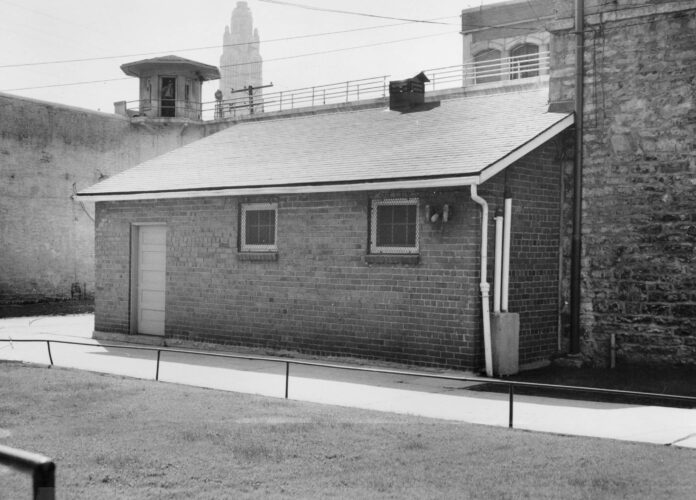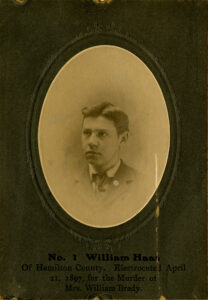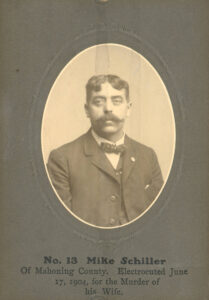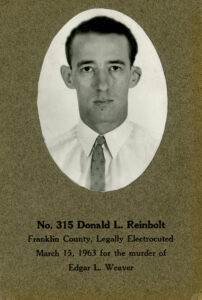Crime and Punishment: The Electric Chair in Ohio

The death penalty has been a part of Ohio’s justice system since early in the state’s history. From 1803 to 1885, public hangings were the form of execution, and these punishments were carried out in the county where the crime was committed.
After a series of botched hangings, a growing concern began for the use of hanging as a method of execution. In 1886, New York State governor David B. Hill formed the Gerry commission to investigate a more humane means of execution. During this time, a dentist named Alfred P. Southwick attended a Buffalo scientific society lecture. During the lecture, a coroner discussed their findings of an individual who had died instantly, after being electrocuted. Southwick was inspired to find an application for this phenomenon. Working alongside George E. Fell, the two conducted experiments, electrocuting hundreds of animals. Studying his findings, Southwick worked out calculations to develop a method that would work on humans. He adopted a modified version of the dental chair to restrain the condemned, inventing the electric chair.

In 1897, the electric chair replaced the gallows. The first prisoner, in Ohio, to be executed by electrocution was William Haas, a 17-year-old boy from Hamilton County, for the murder of Mrs. William Brady. According to the Alliance Standard Review, “The crime for which Haas was electrocuted was a revolting one. He had been employed and befriended by William Brady. On the morning of July 3, 1896, while Brady was absent in Cincinnati, Haas criminally assaulted Mrs. Brady, and then cut her throat with a razor. To cover up the crime Haas set fire to the house and fled.” Later the article states, “Haas was the first to be electrocuted. He was strapped in the chair at 12:27. When he was brought into the electrocution room, he closely scrutinized the chair and was pushed into it. The current was turned on for a period of two seconds, three times in succession.” (The Alliance Standard Review, 1897, p. 15)
All sentences of capital punishment were carried out at the Ohio Penitentiary in Columbus, Ohio. In 1913, the Death House was built specifically to house the electric chair (or “Old Sparky”) and inmates who were sentenced to death. Although deemed to be “far, far in advance of the brutal hangings in vogue in Ohio for so many years and still practiced in less enlightened communities.” (The Athens Gazette, 1904, p.2) There were still several botched executions using this new lethal invention.

Mike Schiller was a bartender in Youngstown, Ohio who stabbed his wife to death, after learning that she had filed for divorce and was planning to return home to Hungary. Schiller was found guilty of murder and sentenced to death. On June 17, 1904, he “was electrocuted in the annex at the Ohio penitentiary at midnight. There was a hitch in the execution and the condemned man revived three times after the electric current had been applied.” (The Daily Journal-Herald, 1904, p. 1). “The electrocution of Schiller was dramatic and awful from the start. The death agony which, in successful electrocutions lasts only a moment, extended over half an hour. ‘He still lives,’ said Dr. Thomas, and the warden ordered the twice-electrocuted man, supposedly dead, to be placed back in the death chair. With a final gasp Schiller sank back into the chair and the current was allowed to pass through his body for a full minute.”
The failure of the execution was not understood by prison officials and after the board of the penitentiary investigated the incident, they attributed, “the difficulty in the electrocution to Schiller’s strong power of resistance.” (Clinton Republican, 1904, p.3)
The last person to be executed by electrocution in Ohio, was Donald Reinbolt. He was executed on March 15, 1963. In total, 315 inmates were put to death in the electric chair, including three women.

Sources:
The Alliance Standard Review, April 23, 1897, page 15. https://ohiomemory.org/digital/collection/p16007coll36/id/117630
The Daily Journal-Herald, June 17, 1904, page 1. https://ohiomemory.org/digital/collection/p16007coll56/id/73193
Athens Country Gazette, June 23, 1904, page 2.
https://ohiomemory.org/digital/collection/p16007coll41/id/2868
The Clinton Republican, June 23, 1904, page 3.
https://ohiomemory.org/digital/collection/p16007coll112/id/2175
Thank you to Aimee Truitt, Catalog & Metadata Coordinator at the Ohio History Connection, for this week’s post!



Leave a Reply
You must be logged in to post a comment.